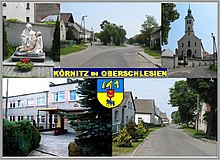Kórnica
| Kórnica | ||
|---|---|---|
 Help on coat of arms |
|
|
| Basic data | ||
| State : | Poland | |
| Voivodeship : | Opole | |
| Powiat : | Krapkowice | |
| Gmina : | Krapkowice | |
| Geographic location : | 50 ° 24 ′ N , 17 ° 55 ′ E | |
| Residents : | 700 | |
| Postal code : | 47-300 | |
| Telephone code : | (+48) 77 | |
| License plate : | OKR | |
| Economy and Transport | ||
| Street : | Krapkowice - Głogówek | |
| Next international airport : | Katowice | |
Kórnica ( German Körnitz ) is a village in the urban-and-rural municipality Krapkowice , Opole Voivodeship in Poland .
geography
Geographical location
Kórnica is about ten kilometers southwest of the municipal seat and the district town of Krapkowice (Krappitz) and thirty kilometers south of the voivodeship capital Opole .
Village structure
The town Kórnica is made up of the original village Körnitz , the 1,714-scale service settlement Schekai , the 1784 by Cistercians from Kasimir founded / Kerpen Frederick colony Reiterndorf , and which was founded in 1826 Vorwerk Agnesenhof ,
history
Körnitz was first mentioned in a document dated October 30, 1323 , in which the heir Werner I. von Körnitz is mentioned. Werner I. von Körnitz came shortly before to Körnitz with his wife Dobislava, his son Andreas, as well as other German settlers from the Lower Silesian village of Duckwitz (near Breslau ) in the course of the German colonization of Upper Silesia . The descendants of Werner I. of Körnitz (Andreas, Jaroslaw, Werner II., Janus and Heinrich) owned the village until 1455. This year belehnte of Opole Duke Bolko V. Heinrich von Müllmen with Körnitz. The village later belonged to Friedrich Schoff, the family of the Redern (1574–1780) and the Counts of Seherr-Thoss.
The Catholic Church of Körnitz was first mentioned in 1433. During the Reformation the church belonged to the Protestants. Parts of the village's population were Protestant until the 17th century. In 1710 a storm destroyed the church and the school. A new church was not built until 1794/95 as a branch of Krappitz . The parish of Körnitz was re-established on May 10, 1851.
In the Upper Silesian referendum of 1921, which was accompanied by fighting , 73% of the residents of Körnitz voted for Upper Silesia to remain part of Germany. In the Second World War , around 100 grains died at the front, during the occupation by the Red Army and after the establishment of the Polish administration. In the summer of 1945, Körnitz became famous for an uprising organized by the local population against the new Polish administration. The parish leader (Scholz) of Kórnica has been Alfons Walczyk from the German minority since 1999 , the office of Catholic parish priest has been exercised by Pastor Josef Niedziela since 1991 and Ryszard Reszczyński has been the director of the Kórnica elementary school since 2004.
population
The village is mainly inhabited by the native Silesian-German population, but there are also some Polish families who have moved here. The population today fluctuates around 700 people.
|
¹ 963 Catholic and 7 Protestant
literature
- Andreas Smarzly: The Körnitzer Uprising. In: Oberschlesien, No. 4 of February 24, 2005 (pp. 12-13).
Web links
Individual evidence
- ↑ See Andreas Smarzly: Körnitz and his beginnings. In: Neustädter Heimatbrief, No. 07.2006 (p. 216–217), 08.2006 (p. 247–248) 09.2006 (p. 249–280) and 10/2006 (p. 311–313)
-
↑
Sources of population figures :
- 1933, 1939: Archived copy ( memento of the original from September 30, 2007 in the Internet Archive ) Info: The archive link was inserted automatically and has not yet been checked. Please check the original and archive link according to the instructions and then remove this notice.



